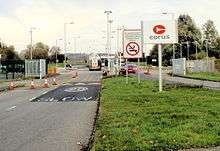Llanwern steelworks



Llanwern Steelworks is located in Llanwern, east of the City of Newport, South Wales.
History
Built for Richard Thomas & Baldwins Ltd, the works was originally referred to locally as "The RTB", before being called Spencer Works and later Llanwern under British Steel Corporation. The steelworks site is situated alongside the South Wales Main Line east of Newport, offering excellent rail transport for the works.
It was the first oxygen-blown integrated steelworks in Britain when it opened in 1962.[1] The hot strip mill pioneered the first successful use of a computer for complete mill control.[2] [3]
The steelworks were built on grassland and wetland that local school children used to roam through on their way to the sea, and which provided a varied habitat for reptiles, amphibians, insects, mammals and birds.
Having won an open internal competition in the 1990s with the Ravenscraig steelworks to become British Steel's leading hot strip mill, in the efforts to increase group and site efficiency in 2001 Steel making ceased at the site with the loss of 1300 jobs. With hot steel slab now imported by rail from the sister Port Talbot steelworks, the mothballed "heavy end" of the Llanwern works was resultantly demolished in 2004.[4]
In January 2009, Corus announced that it was mothballing the hot strip mill, with the loss of over 500 jobs.[5] In August 2009 Corus announced that the hot strip mill would resume operations.[6] Subsequent problems caused by the eurozone crisis forced the company to once again mothball the Hot Strip Mill commencing 24 November 2011 with plans to re-open during late 2012. This stance was released to the press on 2 December 2011.[7]
Present
Tata's operations at Llanwern include a hot strip mill, two pickle lines, a cold strip mill and a hot dip galvanising line. The works rolls 1.5 million tonnes of steel coil per annum for automotive, construction and general engineering applications.[8]
Regeneration
A £115m renewal project called Glan Llyn, led by St. Modwen Properties PLC, is currently transforming the former steel-producing part of the Llanwern steelworks site. Started in 2004, the masterplan envisages 1.5m sq ft of employment-generating accommodation hosting 6,000 jobs, 4,000 new dwellings, community facilities and open space including 3 new lakes. Full completion is anticipated by 2026-8.
References
- ↑ The Welsh Academy Encyclopedia of Wales, University of Wales Press, 2008
- ↑ Aylen, J. (2004). "Megabytes for metals: Development of computer applications in the iron and steel industry" (PDF). Ironmaking & Steelmaking. Institute of Materials, Minerals and Mining / Maney Publishing. 31 (6): 465–478. doi:10.1179/030192304225019324. ISSN 0301-9233.
- ↑ Aylen, J., Natural experiments in innovation: radical adoption of computers and changes to physical and social technologies at Llanwern steelworks, South Wales (PDF), archived from the original (PDF) on 21 March 2012
- ↑ South Wales Argus, September 2004 Missing or empty
|title=(help) - ↑ "Fears for over 1,100 Welsh steel jobs", new.bbc.co.uk, 26 January 2009
- ↑ "Llanwern steel mill to go back to work", www.southwalesargus.co.uk, 20 August 2009
- ↑ "Tata Steel to mothball hot strip mill at Llanwern, Newport", www.bbc.co.uk, 2 December 2011
- ↑ "Tata Steel : About us", www.tatasteeleurope.com, Llanwern works, retrieved September 2012 Check date values in:
|access-date=(help)
Literature
- Jost, H. P. (1964). "The planning and organization of lubrication for a new integrated iron and steel works". Proceedings of the Institution of Mechanical Engineers, Conference Proceedings 1964-1970 (vols 178-184). 179 (1964): 287. doi:10.1243/PIME_CONF_1964_179_090_02., includes description of works c.1964
External links
| Wikimedia Commons has media related to Llanwern steelworks. |
Coordinates: 51°34′31″N 2°53′34″W / 51.57536°N 2.89284°W